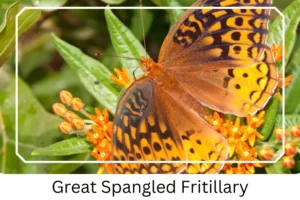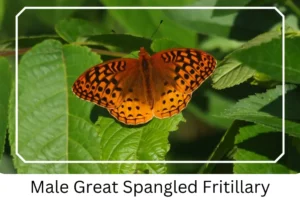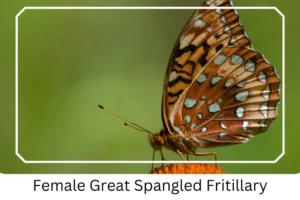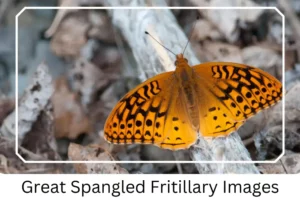Great Spangled Fritillary (Speyeria cybele)
The Great Spangled Fritillary is a fascinating species of butterfly native to North America, celebrated for its vivid orange and tan hues and its presence across a diverse range of habitats. Active predominantly from mid-June to mid-September, these butterflies embody the vibrant pulse of summer meadows and woodland edges.
Scientific Classification
- Family: Nymphalidae
- Genus: Speyeria
- Scientific Name: Speyeria cybele
Overview
This species, with its nine local subspecies, spans a wide geographic range, from the southern reaches of Canada to northern California in the west and North Carolina in the east. The Great Spangled Fritillary plays a crucial role in the pollination ecosystem, fluttering from flower to flower, contributing to the cycle of life in its habitat.
Description and Identification
Caterpillar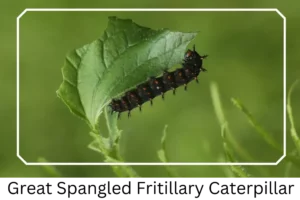
The Great Spangled Fritillary caterpillar is easily recognizable by its jet-black body adorned with spine-like structures. Each spine is tipped with an orange spot, adding a splash of color to the otherwise dark larva. Interestingly, these caterpillars overwinter upon hatching and wait until spring to feed on the tender leaves of violets.
Pupa
Resembling a shelled peanut, the chrysalis of this species boasts a chestnut black or brown hue, complemented by faint orange markings on its glossy surface. This stage is a crucial transformation phase, leading to the emergence of the adult butterfly.
Adult Butterfly
Sexual Dimorphism: There is a noticeable difference between male and female Great Spangled Fritillaries. Males flaunt a tan to orange base color with distinctive black scales on their forewing veins, while females display a tawny, darker shade.
Color and Appearance: When their wings are spread, the intricate patterns and colors of these butterflies are truly mesmerizing. The ventral side of the hindwings features a pale submarginal band and pronounced silver spots, a key identification feature.
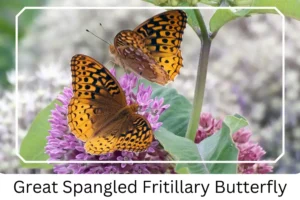
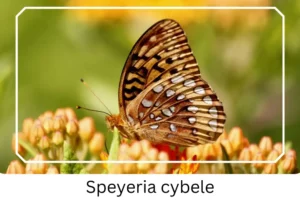 Average Wingspan: The wingspan of the Great Spangled Fritillary ranges from 62 to 88 mm (2.4 to 3.5 inches), placing them among the larger butterfly species in their habitat.
Average Wingspan: The wingspan of the Great Spangled Fritillary ranges from 62 to 88 mm (2.4 to 3.5 inches), placing them among the larger butterfly species in their habitat.
Flight Pattern: These butterflies exhibit a medium-speed flight, often moving in a straight line, a testament to their strong and determined nature.
Eggs
The eggs of the Great Spangled Fritillary are a faint grayish-white, laid individually on the leaves of host plants, ensuring the next generation’s survival.
Quick Facts | |
| Distribution | From south Canada to northern California and east to North Carolina. |
| Habitat | Prefers woodland edges and moist meadows. |
| Lifespan of Adults | 30 to 45 days. |
| Host Plants | Various species of violet (Viola). |
| Adult Diet | Nectar from milkweeds, thistles, purple coneflower, and more. |
How to Identify Great Spangled Fritillary?
Identifying the Great Spangled Fritillary can be a rewarding experience for both amateur and experienced butterfly enthusiasts. Look for their distinctive orange and tan coloration, with males displaying lighter hues and females a darker, tawny color. The silver spots on the underside of their hindwings are key identifiers, alongside the unique pale submarginal band. Observing their flight pattern can also provide clues; their straight, purposeful flight is characteristic. When spotting a caterpillar, search for the signature black body with orange-spotted spines, a telltale sign you’ve found a future Great Spangled Fritillary.
Did You Know?
- In 1985, the Scottish music band Cocteau Twins released a song named “Great Spangled Fritillary,” inspired by the butterfly’s scientific classification within Lepidoptera.
- The Great Spangled Fritillary contributes significantly to the pollination of various plant species, making it an essential part of its ecosystem.
Conclusion
The Great Spangled Fritillary is more than just a beautiful creature; it is a vital component of its ecosystem, a pollinator, and a subject of cultural inspiration. Understanding and appreciating this butterfly’s lifecycle, from its distinctive caterpillar stage to its majestic adult form, enhances our appreciation of the natural world’s complexity and interconnectedness.

